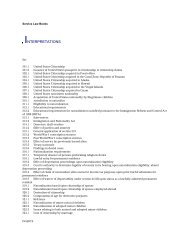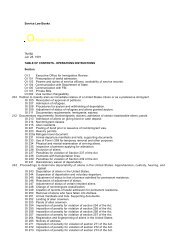Create successful ePaper yourself
Turn your PDF publications into a flip-book with our unique Google optimized e-Paper software.
<strong>Inspector's</strong> <strong>Field</strong> <strong>Manual</strong><br />
(a) General. An alien stowaway is inadmissible to the U.S. and is not entitled to a hearing or review of an<br />
order to remove. [See section 235(a)(2) of the Act and 8 CFR 235.1(d)(4).]<br />
An alien stowaway may be ordered removed on the vessel or aircraft of arrival, or the master may request that<br />
the stowaway be removed from the vessel and repatriated by other means of transportation. Often, this is<br />
requested for reasons of great importance to the carrier, including, but not limited to:<br />
- The health of the stowaway;<br />
- Maintaining insurance coverage (often if several stowaways are on board, a vessel may exceed<br />
capacity and be considered by insurers to be unseaworthy, and so would lose insurance coverage);<br />
- Maintaining the safety and welfare of the crew (especially if the number of stowaways exceeds the<br />
number of crew);<br />
- Sanitary conditions cannot be maintained for the stowaway;<br />
- The vessel's departure is delayed for repairs or goes into drydock;<br />
- The stowaway is a minor or female;<br />
- The vessel is discharging cargo and going off charter and cannot obtain a new charter because the new<br />
charterer will not assume a vessel with stowaways aboard;<br />
- The vessel is of U.S. registry and is not departing the U.S.;<br />
- The vessel will not be returning in the near future to the port where the stowaway boarded the vessel.<br />
Removal of the stowaway by other means should be favorably considered when the removal may be<br />
accomplished expeditiously and the carrier has made, or will make, the necessary transportation arrangements,<br />
including obtaining any necessary travel documents. Although the statute places responsibility for obtaining<br />
travel documents with the carrier, when necessary, the Service may assist the carrier in obtaining travel<br />
documents. See 8 CFR 241.11.<br />
If the stowaway is to be removed on the vessel of arrival, detain him or her on board using Form I-259. Prepare<br />
an I-94, endorsed "Stowaway--refused, detained on board."<br />
If the stowaway cannot be removed immediately, any detention pending removal, other than that incidental to<br />
the actual removal, must be in Service custody, at the expense of the owner of the vessel or aircraft of arrival. If<br />
extended detention is required pending removal, be sure to ascertain that detention space is available before<br />
granting permission to remove by alternate means. Serve Form I-259 on the master or agent of the vessel or<br />
aircraft, and complete Form I-94 endorsed "Stowaway--refused, detained by INS pending removal". If the<br />
stowaway requests asylum, follow procedures described in Chapter 23.18 and 8 CFR 253.1.<br />
(b) Absconded stowaways. The master or agent is required to report the escape of a stowaway who is detained<br />
on board. In such situations, take a sworn statement as described in Chapter 43.3 and institute fine proceedings<br />
under section 243(c).<br />
23.9 Mustering.<br />
Service officers may re-board a vessel at any time after inspection to insure that detained crewmembers remain<br />
on board or that a vessel preparing to depart has all crewmembers present. This function is routinely performed<br />
by Enforcement personnel, but local policy may include the use of Inspections personnel for the activity.<br />
Ordinarily, departure mustering of crew is conducted only on vessels which have a history of immigration<br />
violations or where there are multiple detentions of crewmembers.




